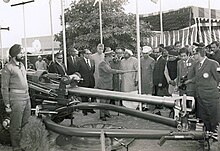|
Indian Field Gun
The Indian Field Gun is a towed field gun developed in India and extensively used in the Indian Army. DevelopmentThe Armament Research and Development Establishment (ARDE) began the design and development of the gun in 1972 to replace the older 25-pounder guns used by the Indian Army. It was produced in the Gun Carriage Factory (GCF), Jabalpur from 1978 onwards.[1][4][5] In addition to the GCF, the guns have been manufactured at Gun Carriage Factory Jabalpur.  The shells are manufactured at ordnance factories in Ambajhari and Chandrapur.[6] It shares many features with the British L118 light gun. It's suitable to operate in mountainous and other difficult terrains, because this gun has excellent portability.[7]  VariantsTowedThe Indian Field Gun (IFG) weighs 3,450 kg (7,610 lb). It has a normal rate of fire of four rounds per minute over ranges from 2,000–17,400 m (6,600–57,100 ft). It can sustain an intense rate of fire of six rounds per minute for up to 10 minutes and a sustained rate of fire for up to one hour. It has a crew of six. The gun has a secondary anti-tank capability. It can operate in temperatures ranging from −27 to +60 °C (−17 to 140 °F). The recoil on firing is absorbed by two side-mounted hydraulic cylinders. A circular platform provided with the gun can be used for rapid 360° movement.[1][2] Manufacture of the Indian Field Gun began in 1978.[1] There are three variants:
The Light Field Gun (LFG) variant weights 2,380 kg (5,250 lb), but retains the same rate of fire and range as the IFG. The LFG can be broken down into two or three parts for easy transport and quickly re-assembled. The LFG can be heli-lifted and paradropped.[1][2] The manufacture of the Light Field Gun began in 1984.[2] There are two variants:
Self propelled
Operators
See alsoReferences
Wikimedia Commons has media related to Indian Field Gun. |
||||||||||||||||||||||||||||||||||||||||||||||||||||||||||||||||||
